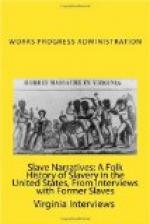The soldiers camped all around everywhere. Lots of them were in tents and some of the officers were in houses. They didn’t burn the college—where Miss Sawyer had taught, you know. The officers used it for their living quarters. They built barracks for the men of upright logs. See that building across the street. It’s been lots of things, a livery stable, veterinary barn, apartment house. But it was one of the oldest buildings in Arkansas. They’ve kept on remodeling it. The Yankees made a commissary out of it. Later on they moved the food up on the square and used it for a hospital. I can remember lots of times seeing the feet of dead men sticking out of the windows.
Your Aunt Nora’s mother saved that building from being burned. How did it happen? Well you see both sides were firing buildings—the Confederates to keep the Yankees from getting them, and the other way about. But the Southerners did most of the burning. Mrs. Blakeley’s little boy was sick with fever. She and a friend went up, because they feared burnings. They sat there almost all night. Parties of men would come along and they would plead with them. One sat in one doorway and the other in the building next. Mrs. Blakely was a Southerner, the other woman a Northerner. Between them they kept the buildings from being burned: saved their own homes thereby and possibly the life of the little sick boy.
It was like that in Fayetteville. There were so many folks on both sides and they lived so close together that they got to know one another and were friends. Things like this would happen. One day a northern officer came over to our house to talk to his wife who was visiting. He said he would be away all day. He was to go down to Prarie Grove to get ’Old Man Parks, dead or alive’. Not until he was on his way did somebody tell him that he was talking about the father of his wife’s hostess. Next day he came over to apologize. Said he never would have made such a cruel remark if he had known. But he didn’t find his man. As the officers went in the front door, Mr. Parks went out of the back and the women surrounded him until he got away.
There was another time when the North and South took refuge together. During the war even the little children were taught to listen for bugle calls and know what they meant. We had to know—and how to act when we heard them. One day, I remember we were to have peas for dinner, with ham hock and corn bread. I was hungry that day and everything smelled so good. But just as the peas were part of them out of the pot and in a dish on the table the signal came ‘To Arms’. Cannon followed almost immediately. We all ran for the cellar, leaving the food as it was.




